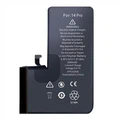Mobile phone battery have become a common usage products. Everyone has a cell phone. Many people are changing their phones frequently. From mobile phone battery development history, we can see that mobile phone with the changes in the form of mobile phones, mobile phone batteries have also made corresponding changes.
Types of mobile phone batteries
Mobile phone batteries are roughly divided into two categories, one is lithium battery, which is the battery used by most smart phones; the other is nickel battery, which was used in some old mobile phones in the past.

(Battery for Nokia)
On this basis, batteries are also subdivided into some small categories, such as lithium batteries, lithium polymer batteries, nickel-cadmium batteries, nickel-hydrogen batteries and so on. In addition to the difference in material, the performance is also very different. They all belong to a kind of "energy storage tool" for mobile phone power supply, while lithium batteries and lithium polymer batteries are the iterative products of nickel-cadmium batteries and nickel-metal hydride batteries.

(Battery for iPhone 12 pro max)
The difference between the two mobile phone batteries
In addition to the performance gap, the biggest gap between lithium batteries and nickel batteries is the "memory effect", because the charging part and the discharging part of nickel batteries are not completely consistent, which will lead to a temporary reduction in the battery capacity and reduce the battery life of the mobile phone. capacity, and this is also the reason for the rumors that "the first time you use a new mobile phone, you need to fully discharge the power".
But lithium-based batteries do not have this problem. In addition to having all the functions of nickel-based batteries, they have been greatly improved. Under the control of the smartphone charging IC system, they surpass nickel-based batteries in all aspects.






